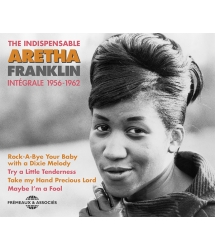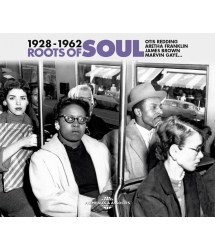- Our Catalog
- Philosophy
- Philosophers of the 20th century and today
- History of Philosophy (PUF)
- Counter-History and Brief Encyclopedia by Michel Onfray
- The philosophical work explained by Luc Ferry
- Ancient thought
- Thinkers of yesterday as seen by the philosophers of today
- Historical philosophical texts interpreted by great actors
- History
- Books (in French)
- Social science
- Historical words
- Audiobooks & Literature
- Our Catalog
- Jazz
- Blues
- Rock - Country - Cajun
- French song
- World music
- Africa
- France
- Québec / Canada
- Hawaï
- West Indies
- Caribbean
- Cuba & Afro-cubain
- Mexico
- South America
- Tango
- Brazil
- Tzigane / Gypsy
- Fado / Portugal
- Flamenco / Spain
- Yiddish / Israel
- China
- Tibet / Nepal
- Asia
- Indian Ocean / Madagascar
- Japan
- Indonesia
- Oceania
- India
- Bangladesh
- USSR / Communist songs
- World music / Miscellaneous
- Classical music
- Composers - Movie Soundtracks
- Sounds of nature
- Our Catalog
- Youth
- Philosophy
- News
- How to order ?
- Receive the catalog
- Manifesto
- Dictionnary











- Our Catalog
- Philosophy
- Philosophers of the 20th century and today
- History of Philosophy (PUF)
- Counter-History and Brief Encyclopedia by Michel Onfray
- The philosophical work explained by Luc Ferry
- Ancient thought
- Thinkers of yesterday as seen by the philosophers of today
- Historical philosophical texts interpreted by great actors
- History
- Books (in French)
- Social science
- Historical words
- Audiobooks & Literature
- Our Catalog
- Jazz
- Blues
- Rock - Country - Cajun
- French song
- World music
- Africa
- France
- Québec / Canada
- Hawaï
- West Indies
- Caribbean
- Cuba & Afro-cubain
- Mexico
- South America
- Tango
- Brazil
- Tzigane / Gypsy
- Fado / Portugal
- Flamenco / Spain
- Yiddish / Israel
- China
- Tibet / Nepal
- Asia
- Indian Ocean / Madagascar
- Japan
- Indonesia
- Oceania
- India
- Bangladesh
- USSR / Communist songs
- World music / Miscellaneous
- Classical music
- Composers - Movie Soundtracks
- Sounds of nature
- Our Catalog
- Youth
- Philosophy
- News
- How to order ?
- Receive the catalog
- Manifesto
- Dictionnary
THE ONLY LIVE RECORDINGS WHERE RAY CHARLES PLAYED ORGAN THROUGHOUT, CONTAINS 25 PREVIOUSLY UNRELEASED TRACKS
RAY CHARLES
Ref.: FA5748
EAN : 3561302574820
Artistic Direction : JOEL DUFOUR
Label : Frémeaux & Associés
Total duration of the pack : 3 hours 55 minutes
Nbre. CD : 3
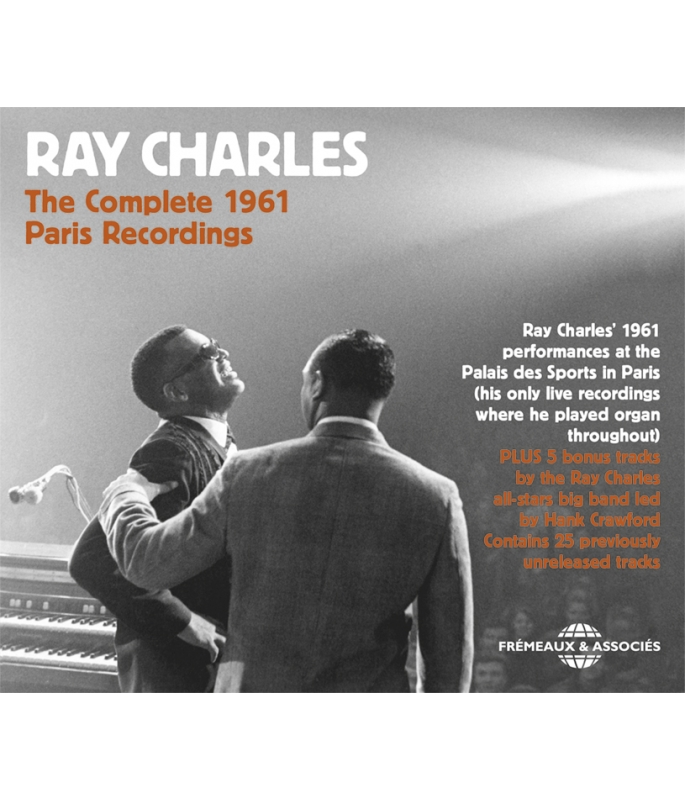
THE ONLY LIVE RECORDINGS WHERE RAY CHARLES PLAYED ORGAN THROUGHOUT, CONTAINS 25 PREVIOUSLY UNRELEASED TRACKS
THE ONLY LIVE RECORDINGS WHERE RAY CHARLES PLAYED ORGAN THROUGHOUT, CONTAINS 25 PREVIOUSLY UNRELEASED TRACKS
After giving an eventful concert in Antibes/Juan-les-Pins in July ‘61, Ray Charles went back to France in October, but this time to Paris for a series of memorable performances. This set was prepared by Joël Dufour, one of the world’s specialists in matters concerning Brother Ray, and its historic value makes it essential listening… because it contains the only live performances where Ray Charles swapped his piano for a Hammond organ. With 25 previously unreleased titles and bonuses, this special box provides a brand-new perspective of the man nicknamed the Genius, a generous, virtuoso musician who enjoyed an imperial reign. Patrick FRÉMEAUX
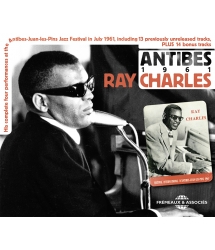
INCLUDING 13 PREVIOUSLY UNRELEASED TRACKS, PLUS 14...
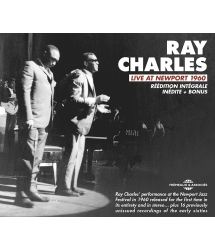
RÉÉDITION INTÉGRALE INÉDITE + BONUS
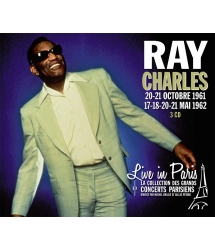
20-21 OF OCTOBER 1961 / 17-18-20-21 OF MAY 1962
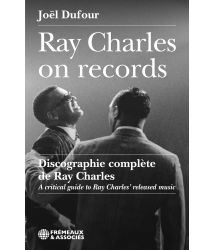
A critical guide to Ray Charles’ released music by...




-
PisteTitleMain artistAutorDurationRegistered in
-
1Stockholm Sweetnin' (From the October 22, 1961, Afternoon Concert)Ray CharlesQuincy Jones00:05:262019
-
2Whisper Not (From the October 22, 1961, Evening Concert)Ray CharlesBenny Golson00:03:102019
-
3One Mint JulepRay CharlesRudolph Toombs00:02:502019
-
4From the HeartRay CharlesRay Charles00:03:332019
-
5Moanin'Ray CharlesBobby Timmons00:03:282019
-
6Let the Good Times RollRay CharlesSam Theard00:02:322019
-
7Georgia on My MindRay CharlesHoagy Carmichael00:07:392019
-
8Hallelujah I Love Her SoRay CharlesRay Charles00:03:122019
-
9Just for a ThrillRay CharlesLil Armstrong00:06:412019
-
10MargieRay CharlesCon Conrad00:02:412019
-
11Alexander's Ragtime BandRay CharlesIrving Berlin00:02:392019
-
12I Believe to My SoulRay CharlesRay Charles00:03:522019
-
13My BonnieRay CharlesRay Charles00:03:372019
-
14I WonderRay CharlesCecil Grant00:03:562019
-
15Sticks and StonesRay CharlesTitus Turner00:03:232019
-
16My BabyRay CharlesRay Charles00:04:432019
-
17Hit the Road JackRay CharlesPercy Mayfield00:02:352019
-
18Come Rain or Come ShineRay CharlesJohnny Mercer00:07:072019
-
19What'd I SayRay CharlesRay Charles00:05:272019
-
PisteTitleMain artistAutorDurationRegistered in
-
1Dat Dere (From the October 22, 1961, Evening Concert)Ray CharlesBobby Timmons00:04:112019
-
2Solitude (From the October 22, 1961, Afternoon Concert)Ray CharlesDuke Ellington00:04:192019
-
3One Mint JulepRay CharlesRudolph Toombs00:02:552019
-
4Moanin'Ray CharlesBobby Timmons00:03:382019
-
5Doodlin'Ray CharlesHorace Silver00:07:522019
-
6From the HeartRay CharlesRay Charles00:03:342019
-
7Hallelujah I Love Her SoRay CharlesRay Charles00:03:192019
-
8Georgia on My MindRay CharlesHoagy Carmichael00:07:292019
-
9MargieRay CharlesCon Conrad00:02:382019
-
10I've Got News for YouRay CharlesAlfred Roy00:04:142019
-
11Alexander's Ragtime BandRay CharlesIrving Berlin00:02:412019
-
12I Believe to My SoulRay CharlesRay Charles00:03:472019
-
13My BonnieRay CharlesRay Charles00:03:342019
-
14I WonderRay CharlesCecil Gant00:03:462019
-
15Yes IndeedRay CharlesSy Oliver00:02:542019
-
16My BabyRay CharlesRay Charles00:04:342019
-
17Hit the Road JackRay CharlesPercy Mayfield00:02:322019
-
18I'm Gonna Move to the Outskirts of TownRay CharlesRoy Jacobs00:04:382019
-
19What'd I Say 2Ray CharlesRay Charles00:05:572019
-
PisteTitleMain artistAutorDurationRegistered in
-
1Roll in G (From the October 21, 1961, Concert)Ray CharlesRay Charles00:08:432019
-
2One Mint JulepRay CharlesRudolph Toombs00:02:572019
-
3Doodlin'Ray CharlesHorace Silver00:07:322019
-
4Moanin'Ray CharlesBobby Timmons00:03:442019
-
5Let the Good Times RollRay CharlesSam Theard00:02:322019
-
6Come Rain or Come ShineRay CharlesJohnny Mercer00:06:582019
-
7Hallelujah I Love Her SoRay CharlesRay Charles00:03:202019
-
8I'm Gonna Move to the Outskirts of TownRay CharlesRoy Jacobs00:05:122019
-
9MargieRay CharlesCon Conrad00:02:272019
-
10Georgia on My MindRay CharlesHoagy Carmichael00:07:272019
-
11Alexander's Ragtime BandRay CharlesIrving Berlin00:02:322019
-
12I WonderRay CharlesCecil Gant00:03:592019
-
13My BonnieRay CharlesRay Charles00:03:562019
-
14My BabyRay CharlesRay Charles00:04:312019
-
15Hit the Road JackRay CharlesPercy Mayfield00:02:332019
-
16I Believe to My SoulRay CharlesRay Charles00:03:432019
-
17What'd I SayRay CharlesRay Charles00:05:562019
FA5748 Ray Charles
RAY CHARLES
The Complete 1961
Paris Recordings
Ray Charles’ 1961
performances at the Palais des Sports in Paris
(his only live recordings where he played organ throughout)
PLUS 5 bonus tracks
by the Ray Charles all-stars big band led
by Hank Crawford
Contains 25 previously unreleased tracks
Après un concert événement à Antibes Juan-les-Pins en juillet 1961, Ray Charles revient en France, cette fois ci à Paris, pour une série de concerts mémorables en octobre 1961. Ce coffret, réalisé par Joël Dufour, spécialiste mondial de Brother Ray, a une valeur essentielle et historique. En effet, il regroupe les seules performances live de Ray Charles où il troque son piano pour l'orgue Hammond. Par l'intermédiaire des 25 pistes inédites et bonus qui le composent, ce coffret nous fait redécouvrir sous un angle inédit l'art du Genius, impérial, généreux et virtuose.
Patrick Frémeaux
After giving an eventful concert in Antibes/Juan-les-Pins in July '61, Ray Charles went back to France in October, but this time to Paris for a series of memorable performances. This set was prepared by Joël Dufour, one of the world's specialists in matters concerning Brother Ray, and its historic value makes it essential listening… because it contains the only live performances where Ray Charles swapped his piano for a Hammond organ. With 25 previously unreleased titles and bonuses, this special box provides a brand-new perspective of the man nicknamed the Genius, a generous, virtuoso musician who enjoyed an imperial reign.
Patrick Frémeaux
Ray Charles – The Complete 1961 Paris Recordings
Par Joël Dufour
Ces enregistrements de trois concerts de Ray Charles à Paris en octobre 1961 tiennent une place très particulière, et tout à fait essentielle, parmi tout ce qui a pu être capturé de sa musique.
Car si, par bonheur, d’autres enregistrements « live » ont également saisi l’immense chanteur au sommet de son art, ceux-ci présentent la spécificité d’être les seuls qui soient issus de concerts où il avait substitué à son piano un orgue Hammond, instrument qu’il aura très peu utilisé mais sur lequel il possédait, aussi, un style original particulièrement prégnant.
Ray Charles venait de publier, avec un grand succès, son recueil « Genius + Soul = Jazz », son seul album studio où il avait joué exclusivement de l’orgue et il souhaitait en interpréter une partie du répertoire sur scène avec la même instrumentation. Toutefois, en raison de son poids considérable, l’orgue Hammond posait un épineux problème de transport. Cela explique que Ray ne l’avait fait installer sur scène qu’à Paris, où il devait jouer plusieurs jours consécutifs (du 20 au 22 octobre), tandis que c’était au piano qu’il était apparu lors des autres concerts de la tournée – pour lesquels il ne s’était produit qu’un seul jour dans la même ville (à Zurich le 18 et à Lyon le 19).
En fait, il n’est pas exagéré d’affirmer que l’existence même de ces enregistrements en public de Ray Charles à l’orgue (sans parler de leur survie dans le temps) relève du miracle, tant de sérieux éléments contraires auraient pu empêcher leur matérialisation…
D’abord il aura fallu que ces concerts à Paris se tiennent précisément lors de la très courte période pendant laquelle le « Genius » ressentait une forte motivation à jouer de l’orgue sur scène (1).
De plus on peut considérer que c’était déjà une grande chance que Ray Charles ait pu effectivement venir en Europe afin d’honorer son contrat pour cette tournée d’octobre 1961, quand on sait qu’il était alors constamment exposé à une arrestation en raison de son addiction à l’héroïne (il devait être de nouveau arrêté dès le 14 novembre).
Enfin, la menace d’une annulation pure et simple des concerts parisiens au Palais des Sports avait plané pendant plusieurs jours, en conséquence directe des évènements tragiques qui se déroulaient alors à Paris, en contrepoint des négociations préparatoires à l’indépendance algérienne qui se tenaient entre le gouvernement français du général de Gaulle et le « gouvernement provisoire de la république algérienne », émanation du FLN (Front de Libération Nationale).
Le 17 octobre 1961, à trois jours du premier concert programmé de Ray Charles dans la capitale, la violence avait atteint son paroxysme entre le FLN et la police, après plusieurs mois d’une escalade jalonnée d’assassinats de policiers auxquels avait répondu une réaction sauvage de forces de l’ordre explicitement couvertes par leur hiérarchie.
Pour la nuit de ce mardi 17 octobre, le FLN avait appelé tous les « FMA » (Français Musulmans Algériens) à une manifestation de masse pacifique, avec femmes et enfants, en protestation contre le couvre-feu qui leur était imposé, à eux seuls, depuis le 5 octobre. Une foule évaluée à entre 20 000 et 30 000 personnes déferla dans les rues de Paris. La répression fut féroce (le nombre de morts reste encore un sujet controversé), donnant lieu à des arrestations massives, environ 6 500 des personnes interpellées se retrouvant notamment entassées au Palais des Sports, réquisitionné à cet effet par le préfet de police, Maurice Papon, jusqu’au dimanche soir 22 octobre.
Le 18 octobre, la direction du Palais des Sports porte l’affaire devant le ministre de la justice, Roger Frey, et déclare à la presse qu’elle intentera un procès au cas où elle devrait annuler les concerts, payer un dédit à l’artiste, et rembourser les quelques 20 000 places déjà pré-vendues. Enfin, le lendemain, l’ordre de réquisition est levé, et, devant l’afflux des demandes, deux concerts supplémentaires sont même annoncés pour les 23 et 24 octobre. Là encore, les billets sont vendus en un temps record.
Ce sont donc finalement six concerts de Ray Charles qui se sont tenus à Paris du 20 au 24 octobre 1961 (dont 2 concerts le dimanche 22). La capacité du Palais des Sports étant alors de 5 000 places assises, c’est au minimum 30 000 personnes qui ont assisté à l’un de ces concerts. Bien davantage, en fait, car les témoins oculaires de l’évènement avaient pu constater que de nombreux spectateurs « excédentaires » avaient aussi été admis, à tarif réduit, et avaient envahi les marches entre les rangées.
C’est donc un engouement hors normes que suscitait Ray Charles à cette époque auprès du public français, bien au-delà des seuls amateurs éclairés de jazz et de blues. Le facteur principal susceptible d’expliquer ce fait est probablement le caractère éminemment dansant de sa musique, qu’il s’agisse de rock & roll, de twist ou de slow, qui rendait ses disques incontournables dans les « surprise parties » d’adolescents.
Dans Jazz-Hot, Gérard Brémond observait : « Le public des concerts donnés à Paris était composé dans sa majorité de jeunes de dix-sept ou dix-huit ans de toutes classes sociales », et il rappelait la genèse de ce phénomène : « A l’origine quelques critiques, Guy Kopelowicz, François Postif et Kurt Mohr, à l’écoute des premiers 45 tours parus aux Etats-Unis, découvrent en Ray Charles une personnalité exceptionnelle. Pendant quelques années, Ray Charles est apprécié des seuls amateurs de jazz. C’est Daniel Filipacchi, avec son émission “Salut les copains”, qui le fait connaître aux jeunes amateurs de variétés ».
A cela, il faut ajouter que les alors récentes prestations de Ray Charles au festival de jazz d’Antibes-Juan-les-Pins, en juillet 1961, avaient été diffusées nationalement, tant par la radio RTF que par l’unique chaîne de télévision (2).
Alors qu’en juillet à Antibes Ray Charles était apparu à la tête de son « petit » orchestre de sept musiciens, c’est avec une formation augmentée à seize instrumentistes (réalisation de son rêve de disposer d’un « big band » de type Count Basie) qu’il était revenu en octobre, pour la première fois lors d’une tournée européenne.
La plupart des arrangements étaient de la plume de Quincy Jones, celui-ci (qui avait dû récemment abandonner son propre orchestre) en ayant fait don à son ami Ray.
Ce tout nouveau « big band » débordait littéralement de talents (impossible d’en détailler tous les mérites individuels), même si seuls les saxophonistes David « Fathead » Newman (le soliste primordial de Ray Charles depuis 1954) et Hank Crawford (le chef d’orchestre) devaient chacun mener ensuite une longue et fructueuse carrière personnelle. S’il n’en fut pas de même du bouillant saxo-ténor Don Wilkerson (que Ray encensait au même titre que « Fathead » dans son autobiographie), c’est à cause des difficultés qu’il éprouvait à surmonter des problèmes de drogue qui lui valurent des séjours derrière les barreaux.
Maitrisant une variété de styles, du plus traditionnel à l’avant-garde, le trompettiste Marcus Belgrave se sera, quant à lui, surtout consacré à l’enseignement. C’est apparemment par manque d’ambition, et non de talent, que le trompettiste Phil Guilbeau, brillant émule de Clifford Brown, n’a pas su s’imposer. Il en va de même de Leroy Cooper, sans doute l’un des tout meilleurs saxo-baryton du jazz, dont la carrière s’est largement résumée à sa participation fidèle au Ray Charles Orchestra (qu’il dirigea pendant une décennie).
En ouverture de chaque concert parisien d’octobre 1961, l’annonce faite que Ray Charles lui-même n’arriverait qu’en seconde partie du spectacle avait suscité dans le public une grande déception, exprimée plus ou moins bruyamment. Toutefois la qualité de la musique proposée par l’orchestre dirigé par Hank Crawford, perceptible même par un auditoire non averti, avait fini par avoir raison des protestataires.
En revanche, l’entrée en scène, en seconde partie, de Ray Charles, et, plus tard, celle des Raelets menées par la grande Margie Hendrix, avaient été accueillies dans une liesse tonitruante. Par rapport à Antibes, le programme était largement renouvelé (les pièces également interprétées à Antibes, prenant, de toute façon, une couleur nouvelle de par l’utilisation de l’orgue), en particulier par la présence de trois instrumentaux et des deux magnifiques blues (I’m Gonna Move to the Outskirts of Town et I’ve Got News for You) issus du recueil « Genius + Soul = Jazz », ainsi que par celle des sublimes ballades Just for a Thrill et Come Rain or Come Shine, bénéficiant désormais de nouveaux arrangements pour grand orchestre de jazz signés Quincy Jones. Quant à Georgia on My Mind, déjà au répertoire à Antibes, le Genius en donne ici ses plus belles versions, magnifiées par son subtil jeu d’orgue.
A partir du moment où Ray Charles a eu son premier « big band », il a toujours continué à en maintenir un, où sera passé un nombre incalculable de musiciens, plus ou moins célèbres ou obscurs. Mais le lien tissé avec les instrumentistes qui formaient le noyau de son orchestre des années 1950 était resté très puissant, comme en témoignent au moins huit réunions pour des engagements ponctuels, entre 1977 et 1999. En 2009, cinq ans après le décès de Ray Charles, disparaissaient à leur tour, en quinze jours de temps, Leroy Cooper, David Newman et Hank Crawford.
Il ne fait malheureusement aucun doute que c’est une énorme partie de la merveilleuse musique interprétée sur scène par ces artistes d’exception qui n’a jamais fait l’objet d’un quelconque enregistrement. Prenons donc la mesure de notre chance que, dès que Ray Charles a mis le pied en Europe, en 1961, radios et télévisions aient enregistré certains de ses concerts, en saisissant contraste avec ce qu’était alors la quasi-totale indifférence des médias audio-visuels américains à l’égard de ses prestations publiques (3).
Joël Dufour
© Frémeaux & Associés 2019
(1) C’est à titre exceptionnel qu’il avait, en plus du piano, rejoué de l’orgue (le temps de cinq morceaux) lors de son concert de 1964 au Shrine Civic Auditorium de Los Angeles [CD « Ray Charles Live in Concert », Concord CRE-31439], sans doute à la faveur de la facilité de transport offerte par la proximité de son propre studio d’enregistrement (RPM).
(2) Ces concerts sont disponibles dans leur intégralité dans le coffret CD « Ray Charles – Antibes 1961 » (Frémeaux & Associés FA 5733).
(3) La notable exception à cette « règle » a été, en 1960, l’enregistrement de sa prestation au festival de Newport réalisé par la radio « Voice of America » [intégralement publiée dans le coffret CD « Ray Charles – Live at Newport 1960 », Frémeaux & Associés FA 5643]. Incidemment, cette station gouvernementale U.S. ne diffuse qu’en direction des pays étrangers…
Livres consultés :
-Brother Ray – Ray Charles’ Own Story, par Ray Charles & David Ritz (Da Capo)
-Paris 1961, par Jim House & Neil McMaster (Oxford University Press)
Magazine et journaux consultés :
-“Ray Charles le plus humain des chanteurs” par Gérard Brémond, in JAZZ HOT n°171, Dec. 1961.
-La presse quotidienne française : Le Parisien Libéré, France-Soir, Paris-Jour, L’Aurore, Paris-Presse…
Remerciements à :
Bob Stumpel, Adriano Mazzoletti, Olivier Gillissen, Jean-Francis Merle, David Ritz, Michelle Dufour, Jack Evans, Jeff Helgesen, Robbie Kwock, Steve Sigmund, Alan Leeds.
Ray Charles – The Complete 1961 Paris Recordings
By Joel Dufour
These recordings of three Ray Charles concerts in Paris in October 1961 hold a very special, and most essential, place among all of what has been captured of his music.
Because if, fortunately, other live shows of that supreme singer at the peak of his art have also been committed to tape, these have the specificity of being the only ones coming from concerts where he had substituted to a piano his Hammond organ, an instrument that he will have scarcely used but on which he also possessed a particularly original and striking style.
Ray Charles had recently released with great success his “Genius + Soul = Jazz”, his only studio album where he had played exclusively organ and he wished to preform part of its material on stage with the same instrumentation. Yet, because of its huge weight, the Hammond organ constituted a nagging transportation problem. That explains that Ray had it set up on stage only in Paris, where he was to play several consecutive days (from the 20th to the 22nd of October), whereas he had appeared on piano at the concerts where he was to play a single day in the same town (in Zurich on the 18th and in Lyon on the 19th).
Fact is that it is no exaggeration to state that the very existence of these live recordings of Ray Charles playing organ (not to mention their survival over time) is nothing short of a miracle, since serious odds could have rendered them impossible.
To begin with, it took the fluke that these concerts occurred precisely during the very short period of time during which the “Genius” was feeling strongly motivated to play organ on stage (1).
Furthermore, one can consider that it already was out of great luck that Ray Charles had been able to actually cross the Atlantic to fulfil his October 1961 European tour commitments, when one knows that he then was constantly exposed to an arrest because of his heroin addiction (he would be arrested again on the 14th of November).
Lastly, the danger of a mere cancellation of the concerts at the Palais des Sports in Paris had menaced during several days, in direct consequence of the tragic events which were going on in Paris alongside the ongoing negotiations, with a view to preparing the Algerian independence, between the French government of general de Gaulle and the FLN (“Front de Libération Nationale” – National Liberation Front)
On October 17th, 1961, just three days before the first scheduled Ray Charles concert in Paris, violence had reached a climax between the FLN and the police, after several months of escalation marked by assassinations of policemen which had been matched by a wild reaction of policemen explicitly endorsed by their hierarchy.
For the Tuesday, October 17th, the FLN had called all the “FMA” (“Français Musulmans Algérien” – French Muslim Algerian) to a peaceful mass demonstration, with women and children, as a protest against the curfew which was imposed, on them only, since October 5th.
A crowd estimated in between 20 000 and 30 000 people poured in the streets of Paris. The repression was wild (the number of deaths remains debated), giving rise to massive arrests, approximately 6 500 of the seized people finding themselves piled up in the Palais des Sports, requisitioned for that purpose by the Chief of Police, Maurice Papon, until Sunday evening, October 22nd.
On October 18th, the management of the Palais des Sports brings the issue in front of the Minister of Justice, Roger Frey, and declares to the press that it will file a lawsuit in case it should have to cancel concerts, to pay a revocation to the artist, and to pay off some 20 000 already presold tickets. Finally, the next day, the order of requisition is raised, and, in front of the influx of the requests, two additional concerts are even announced for October 23rd and 24th. Even there, tickets are sold in record time.
It is thus finally six Ray Charles’s concerts which took place in Paris from 20th till 24th October 1961 (among which 2 concerts on Sunday, 22nd). The capacity of the Palais des Sports being then of 5 000 seats, it is at least 30 000 people who attended one of these concerts. Much more, in fact, because the eyewitnesses of the event had been able to notice that numerous additional spectators had also been admitted, at a reduced price, and had invaded the steps between rows.
Thus, it is an exceptional craze which Ray Charles had given rise to at that time near the French public, well beyond the sole informed fans of jazz and blues. The main factor susceptible to explain this fact is probably the eminently danceable character of his music, be it rock and roll, twist or slow dance, which made his records inescapable at any teenagers’ party.
In Jazz-Hot, Gérard Brémond observed: “The audience of concerts given in Paris consisted in its majority of young people being seventeen or eighteen years old, of all social classes”, and he reminded the genesis of this phenomenon: “originally some critics, Guy Kopelowicz, François Postif and Kurt Mohr, tuned to the first 45rpm records released in the United States, discover in Ray Charles an exceptional personality. For a few years, Ray Charles is appreciated only by jazz fans. It is Daniel Filipacchi, with his radio program “Salut les Copains” (“Hello buddies”), which makes him known by the young fans of pop music”.
To this, it is necessary to add that the then recent performances of Ray Charles at the jazz festival of Antibes-Juan-les-Pins, in July 1961, had nationally been broadcast by the RTF radio, as well as by the only French television channel (2).
While in July at Antibes Ray Charles had appeared at the head of his “small” band of seven musicians, it is fronting an orchestra augmented to sixteen instrumentalists (realization of his dream to have a Count Basie-type “big band”) that he had arrived in Paris, for the first time during a European tour.
Most of the arrangements had been penned by Quincy Jones, who recently had had to give up his own orchestra. He had given them to his friend Ray.
This brand-new big band was literally overflowing with talents (impossible to detail all the individual merits), even if only the saxophonists David “Fathead” Newman (the essential soloist for Ray Charles since 1954) and Hank Crawford (the band leader) would each enjoy a long and fruitful personal career. If it was not to be the same for the boiling sax-tenor Don Wilkerson (that Ray praised as much as he did “Fathead” in his autobiography), it is because of the difficulties he was experiencing in his attempts at overcoming drugs problems which cost him stints behind prison bars.
Mastering a variety of styles, from the most traditional to the avant-garde, trumpeter Marcus Belgrave focused mostly on a career as a music teacher. It is apparently due to a lack of ambition, and not of talent, that trumpeter Phil Guilbeau, the brilliant Clifford Brown emulator, did not manage to stand out. The same can be said about Leroy Cooper, doubtless one of the best baritone-sax players in jazz, whose career mostly amounted to his faithful participation to the Ray Charles Orchestra (which he led during a decade).
At the opening of every Parisian concert of October 1961, the announcement made that Ray Charles himself would arrive only in the second part of the show had aroused a great disappointment in the public, more or less noisily expressed. However, the quality of the music proposed by the orchestra led by Hank Crawford, perceptible even by non-specialists, had eventually silenced the protesters.
On the other hand, the arrival on the scene, in the second part, of Ray Charles, and, later, the one of the Raelets led by the great Margie Hendrix, had been welcomed in a resounding jubilation. As compared with Antibes, the program was widely renewed (the tunes also performed in Antibes taking, anyway, a new color due to the use of the organ), in particular by the presence of three instrumentals and the two magnificent blues (I’m Gonna Move to the Outskirts of Town and I’ve Got News for You) stemming from the « Genius + Soul = Jazz » album, as well as by the one of the sublime ballads Just for a Thrill and Come Rain or Come Shine, now benefiting from new arrangements for a large jazz orchestra written by Quincy Jones. As for Georgia on My Mind, already in the repertoire in Antibes, the Genius gives here his most beautiful renditions, heightened by his fine organ playing.
From the moment Ray Charles had his first big band, he always kept maintaining one, where have passed countless musicians, famous or obscure. But the link weaved with the instrumentalists who formed the core of his or-
chestra of the 1950s had remained very powerful, as demonstrated by the fact that they would reunite, at least eight times, for punctual gigs between 1977 and 1999. In 2009, five years after the death of Ray Charles, in the span of a fortnight, Leroy Cooper, David Newman and Hank Crawford passed away.
There is unfortunately no doubt that it is an enormous portion of the wonderful music performed on stage by these exceptional artists which never was the object of any recording. Thus, let us take the measure of our luck that, as soon as Ray Charles set a foot in Europe, in 1961, radios and televisions recorded some of his concerts, in salient contrast with what was then the quasi-total indifference of the American audio-visual media regarding his live performances (3).
Joël Dufour
© Frémeaux & Associés 2019
(1) It was as an exception that, besides the piano, he had also played organ again (on five songs) during his 1964 concert at the Shrine Civic Auditorium of Los Angeles [CD « Ray Charles Live in Concert », Concord CRE-31439], probably because the proximity of his own recording studio (RPM) had made its transportation rather easy.
(2) These concerts have been released in their entirety in the CD box set « Ray Charles – Antibes 1961 » (Frémeaux & Associés FA 5733).
(3) The notable exception to that “rule” was, in 1960, the recording of his performance at the Newport Jazz Festival by the “Voice of America” radio [released in its entirety in the CD box set « Ray Charles – Live at Newport 1960 », Frémeaux & Associés FA 5643]. Incidentally, this U.S. government owned radio station broadcasts exclusively towards foreign countries.
Consulted books:
-Brother Ray – Ray Charles’ Own Story, by Ray Charles & David Ritz (Da Capo)
-Paris 1961, by Jim House & Neil McMaster (Oxford University Press)
Consulted magazine and newspapers:
-“Ray Charles le plus humain des chanteurs” by Gérard Brémond, in JAZZ HOT n°171, December 1961.
-The daily newspapers: Le Parisien Libéré, France-Soir, Paris-Jour, L’Aurore, Paris-Presse…
Thanks to:
Bob Stumpel, Adriano Mazzoletti, Olivier Gillissen, Jean-Francis Merle, David Ritz, Michelle Dufour, Jack Evans, Jeff Helgesen, Robbie Kwock, Steve Sigmund, Alan Leeds.
Composition
du triple-CD
et renseignements
discographiques :
(*) Previously unreleased
CD-1 (79:53)
The Ray Charles Orchestra (bonus tracks)
1. Stockholm Sweetnin’ / solo: JH, HC, SF (from the October 22, 1961, afternoon concert) (*)
2. Whisper Not / solo: DN. (from the October 22, 1961, evening concert) (*)
Ray Charles & his orchestra:
the October 21, 1961, performance
3. One Mint Julep
4. From the Heart / solo: PG
5. Moanin’ / solo: PG (*)
6. Let the Good Times Roll / solo: DN (*)
7. Georgia on My Mind / solo: DN (*)
8. Hallelujah I Love Her So / solo: DW (*)
9. Just for a Thrill / solo: MB
10. Margie
11. Alexander’s Ragtime Band / solo: MB (*)
12. I Believe to My Soul (*)
13. My Bonnie / solo: DN (*)
14. I Wonder
15. Sticks and Stones
16. My Baby (I Love Her, Yes I Do) / featuring Margie Hendrix
17. Hit the Road Jack / featuring Margie Hendrix (*)
18. Come Rain or Come Shine / solo: DW
19. What’d I Say (*)
CD-2 (79:25)
The Ray Charles Orchestra (bonus tracks)
1. Dat Dere / solo: HC (from the October 22, 1961, evening concert) (*)
2. Solitude / solo: LC (from the October 22, 1961, afternoon concert) (*)
Ray Charles & his orchestra: the October 22, 1961,
afternoon performance
3. One Mint Julep (*)
4. Moanin’ / solo: PG
5. Doodlin’ / solo: PG, DN, LC
6. From the Heart / solo: PG (*)
7. Hallelujah I Love Her So / solo: DW (*)
8. Georgia on My Mind / solo: DN (*)
9. Margie (*)
10. I’ve Got News for You
11. Alexander’s Ragtime Band / solo: MB
12. I Believe to My Soul
13. My Bonnie / solo: DN
14. I Wonder (*)
15. Yes Indeed / solo: DN
16. My Baby (I Love Her, Yes I Do) / featuring Margie Hendrix
17. Hit the Road Jack / featuring Margie Hendrix
18. I’m Gonna Move to the Outskirts of Town / solo: PG
19. What’d I Say
CD-3 (78:10)
The Ray Charles Orchestra (bonus track)
1. Roll in G / solo: DW (from the October 21, 1961, concert) (*)
Ray Charles & his orchestra: the October 22, 1961,
evening performance
2. One Mint Julep (*)
3. Doodlin’ / solo: PG, DN, LC (*)
4. Moanin’ / solo: PG (*)
5. Let the Good Times Roll / solo: DN
6. Come Rain or Come Shine / solo: DW
7. Hallelujah I Love Her So / solo: DW
8. I’m Gonna Move to the Outskirts of Town / solo: PG
9. Margie
10. Georgia on My Mind / solo: DN
11. Alexander’s Ragtime Band / solo: MB
12. I Wonder
13. My Bonnie / solo: DN (*)
14. My Baby (I Love Her, Yes I Do) / featuring Margie Hendrix (*)
15. Hit the Road Jack / featuring Margie Hendrix
16. I Believe to My Soul
17. What’d I Say
The original RTF radio recordings were produced by André Francis.
Repertoire
-Alexander’s Ragtime Band (Irving Berlin) [arrangement: Ralph Burns]
-Come Rain or Come Shine (Johnny Mercer, Harold Arlen) [arrangement: Quincy Jones ]
-Dat Dere (Bobby Timmons) [arrangement: Hank Crawford ]
-Doodlin’ (Horace Silver) [arrangement: Quincy Jones ]
-From the Heart (Ray Charles) [arrangement: Quincy Jones ]
-Georgia on My Mind (Hoagy Carmichael, Stuart Gorrell)
-Hallelujah I Love Her So (Ray Charles) [arrangement: Ray Charles]
-Hit the Road Jack (Percy Mayfielf) [arrangement: Ray Charles]
-I Believe to My Soul (Ray Charles) [arrangement: Ray Charles]
-I Wonder (Cecil Gant) [arrangement: Ray Charles]
-I’m Gonna Move to the Outskirts of Town (Roy Jacobs, Andy Razaf, William Weldon)
[arrangement: Quincy Jones ]
-I’ve Got News for You (Roy Alfred) [arrangement: Ralph Burns]
-Just for a Thrill (Lil Armstrong, Don Raye) [arrangement: Quincy Jones ]
-Let the Good Times Roll (Sam Theard, Fleecie Moore) [arrangement: Quincy Jones ]
-Margie (Con Conrad, Joseph Russel Robinson, Benny Davis) [arrangement: Marty Paich]
-Moanin’ (Bobby Timmons) [arrangement: Quincy Jones ]
-My Baby (I Love Her, Yes I Do) (Ray Charles) [arrangement: Ray Charles]
-My Bonnie (Ray Charles) [arrangement: Ray Charles]
-One Mint Julep (Rudolph Toombs) [arrangement: Quincy Jones ]
-Roll in G (?)
-Solitude (Duke Ellington) [arrangement: Quincy Jones ]
-Sticks and Stones (Titus Turner) [arrangement: Ray Charles]
-Stockholm Sweetnin’ (Quincy Jones) [arrangement: Quincy Jones ]
-What’d I Say (Ray Charles) [arrangement: Ray Charles]
-Whisper Not (Benny Golson) [arrangement: Quincy Jones ]
-Yes Indeed (Sy Oliver) [arrangement: Ray Charles]
Personnel
Ray Charles (organ, lead vocals) & his orchestra: Marcus Belgrave, Wallace Davenport, Phillip Guilbeau (trumpet); John Hunt (flugelhorn); Henderson Chambers, Edward Lee Comegys, James Lee Harbert, Frederic “Keg” Johnson (trombone); “Hank” Crawford [Bennie Ross Crawford, Jr.] (band leader, alto saxophone, organ on “Roll in G”); Everard “Rudy” Powell (alto saxophone); David “Fathead” Newman (tenor saxophone, flute); Donald “Don” Wilkerson (tenor saxophone); Leroy “Hog” Cooper (baritone saxophone); Elbert “Sonny” Forriest (guitar); Edgar Willis (bass); Edward “Bruno” Carr (drums); the Raelets: Gwendolyn “Gwen” Berry, “Margie Hendrix” [Marjorie Hendricks], Priscilla “Pat” Moseley Lyles, Ethel “Darlene” McCrea (background vocals).
